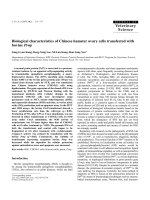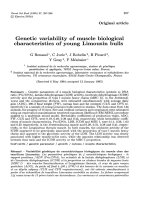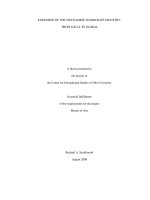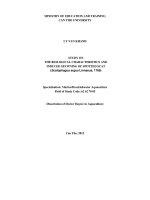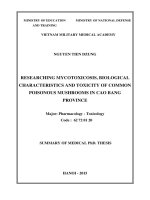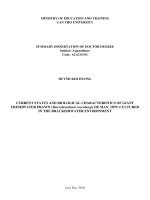Evalution of agro biological characteristics of local vietnamese hot pepper germplasm in outumn winter season 2020 in gia lam ha noi
Bạn đang xem bản rút gọn của tài liệu. Xem và tải ngay bản đầy đủ của tài liệu tại đây (4.16 MB, 68 trang )
VIETNAM NATIONAL UNIVERSITY OF AGRICULTURE
FACULTY OF AGRONOMY
UNDERGRADUATE THESIS
TITLE:
EVALUTION OF AGRO - BIOLOGICAL
CHARACTERISTICS OF LOCAL VIETNAMESE HOT
PEPPER GERMPLASM IN AUTUMN - WINTER
SEASON 2020 IN GIA LAM - HA NOI
Student
DOAN LINH HUONG
Student code
610033
Class
K61KHCTT
Supervisor
Assoc.Prof.PhD. TRAN THI MINH HANG
Department
Horticulture
HA NOI - 2021
CONFIRMATION
We confirm that this is our own research. The data and results shown in
report are realistic and have never published in any other reports.
We affirm that all the helps during research are acknowledged and
reference sources are shown clearly.
Hanoi, March 2021
Thesis author
Doan Linh Huong
i
ACKNOWLEGEMENTS
In performing my undergraduate thesis, it is a successful one I had to take
the help and guideline of number of respected persons.
Foremost, I am deeply grateful to my advisor, Assoc.Prof.PhD Tran Thi
Minh Hang, Department of Horticulture - Faculty of Agronomy, Vietnam
National University of Agriculture for her help throughout my undergraduate
thesis at Vietnam National University of Agriculture. Her advice, guidance,
professionalism, and understanding of the scientific process have greatly
contributed to my learning experience.
My sincere thanks also go to teachers in the Faculty of Agronomy,
Vietnam National University of Agriculture, whose encouragement, guidance
and inspiration supported me during my studying time at higher education.
Besides that, I am thankful to my dear classmates, K61KHCTT, for all the time
we had in the last four years.
Last but not least, special thanks are given to my parents for all their help,
encouragement and love over the years.
Thank you very much!
Hanoi, March 2021
Thesis author
Doan Linh Huong
ii
CONTENTS
CONFIRMATION..................................................................................................i
ACKNOWLEGEMENTS.....................................................................................ii
LIST OF TABLES................................................................................................v
LIST OF FIGURES..............................................................................................vi
ABSTRACT.........................................................................................................vi
PART I: INTRODUCTION...............................................................................1
1.1. Rationale of the study:....................................................................................1
1.2. The purposes and requirements:.....................................................................1
PART II: LITERATURE REVIEW..................................................................3
2.1. ORIGIN AND CLASSIFICATION OF HOT PEPPER ACCESSIONS:......3
2.1.1. Origin...........................................................................................................3
2.1.2. Classification...............................................................................................4
Botanical characteristics of species in the genus Capsicum..................................5
2.2. GROWTH AND DEVELOPMENT CHARACTERISTICS OF HOT PEPPER
ACCESSIONS:......................................................................................................6
2.3. REQUIREMENT OF HOT PEPPER PLANT ON ENVIRONMETAL
CONDITION:........................................................................................................8
2.3.1.Temperature:................................................................................................8
2.3.2.Light.............................................................................................................9
2.3.3.Humidity.....................................................................................................10
2.3.4. Soil and nutrition........................................................................................10
2.3.5. Situation of collection and assessment of hot pepper genetic resources in
the world and Vietnam:.......................................................................................11
PART III: MATERIALS AND METHODS...................................................26
3.1. MATERIALS...............................................................................................26
3.2. TIME AND SITE:........................................................................................26
3.3. RESEARCH CONTENT.............................................................................27
iii
3.4. DATA PROCESSING METHODS.............................................................27
3.5. RESEARCH METHODS:............................................................................27
3.5.1. Experimental arrangement method:..........................................................27
3.5.2. Evaluation parameters and methods:.........................................................27
3.5.3. Planting and caring techniques:.................................................................28
PART IV: RESULTS AND DISCUSSION.....................................................32
4.1. GERMINATION RATE OF HOT PEPPER ACCESSIONS IN AUTUMN WINTER SEASON 2020 IN GIA LAM - HA NOI:..........................................32
4.2. GROWTH AND DEVELOPMENT TIME OF HOT PEPPER ACCESSIONS
IN AUTUMN - WINTER SEASON 2020 IN GIA LAM - HA NOI.....................33
4.3. GROWTH CHARACTERISTICS OF HOT PEPPER ACCESSIONS IN
AUTUMN - WINTER 2020 IN GIA LAM - HA NOI.......................................35
PART V: CONCLUSION AND SUGGESTION............................................54
5.1. CONCLUSION............................................................................................54
5.2. SUGGESTION.............................................................................................54
REFERENCES..................................................................................................55
iv
LIST OF TABLES
Table 1. Germination rate of hot pepper accessions grown in Autumn - Winter
season 2020 in Gia Lam - Ha Noi.......................................................................32
Table 2. Growth and development period of hot pepper accessions grown in
Autumn - Winter season 2020 in Gia Lam - Ha Noi...........................................33
Table 3. Height growth rate of hot pepper accessions grown in Autumn - Winter
season 2020 in Gia Lam - Ha Noi.......................................................................35
Table 4. Leaves growth rate of hot pepper accessions grown in Autumn - Winter
season 2020 in Gia Lam - Ha Noi.......................................................................37
Table 5. Growth characteristics of hot pepper accessions grown in Autumn Winter season 2020 in Gia Lam - Ha Noi...........................................................40
Table 6. Morphological characteristics of leaves of hot pepper accessions grown
in Autumn - Winter season in Gia Lam - Ha Noi...............................................42
Table 7. Flowering, fruiting and individual yield of hot pepper accessions grown
in Autumn - Winter season 2020 in Gia Lam - Ha Noi......................................44
Table 8. Morphological characteristics of the fruit of hot pepper accessions
grown in Autumn - Winter season 2020 in Gia Lam - HaNoi............................46
Table 9. Fruit structure of hot pepper accessions grown in Autumn - Winter
season 2020 in Gia Lam - Ha Noi.......................................................................47
Table 10. Disease of hot pepper accessions in Autumn - Winter season 2020 in
Gia Lam - Ha Noi................................................................................................48
v
LIST OF FIGURES
Figure 1. Beds to planting hot pepper accessions in Autumn – Winter 2020
season 2010 in Gia Lam – Ha Noi......................................................................29
Figure 2. Seedlings of Chi2 accession in Autumn – Winter season 2020 in Gia
Lam – Ha Noi......................................................................................................30
Figure 3. Manh Ho insecticide to kill Red spider mite.......................................31
Figure 4. Leaf morphology of chili pepper accessions.......................................51
Figure 5. Fruit morphology of chilli pepper accessions......................................52
Figure 6. Hot pepper plant was damaged Red spider mite (Tetranychus urticae).....53
.
vi
ABSTRACT
Nine Vietnamese local hot pepper accsessions have evaluated agro biological characteristics in Autumn - Winter season 2020 in Gia Lam - Ha Noi.
When I wrote this undergraduate thesis, all of hot pepper accessions have not yet
been red ripe but I can give some information. Chi2, Chi3 and Chi4 accessions
should be used in hot pepper breeding programs in the future because they had
beautiful shape, good growth and development and were not damaged by pest
and disease. Other hot pepper accessions have moderate growth. However,
Chi11 was damaged seriously by red spider. There were clear different among
hot pepper accessions in terms of growing period, growth, flowering and fruit
characteristics.
vi
PART I
INTRODUCTION
1.1. Rationale of the study:
Hot pepper (Capsicum annuum L.) is one of important fruit vegetable
belonging to the genus Capsicum of the
Solanaceae family. This family
consists of several high economic - importance vegetables widely grown in the
world. In particular, hot peppers are very popular in many countries, including
Vietnam. Hot peppers contain an impressive list of chemical compounds known
to have preventive and health-promoting properties.
In Vietnam, hot pepper is cultivated nationwide and used for a long time.
In many places, the farmers keep the seeds of hot peppers from year to year by
themself. Therefore there are many different local varieties existing in Vietnam.
Although the productivity is low, these local varieties possessed many valuable
traits, such as high pungency, disease resistance and adaptation
to local
cultivation conditions. The collection and evaluation of these local varieties are
very important works aiming at exploitation of valuable genetic resources for
good hot pepper accession breeding and improvement purpose. For many years,
the Center for Plant Resources has been collecting, storing and conserving a lot
of plant genetic resources, including hot pepper. Based on the samples of hot
pepper accessions provided by the Plant Resources Center, we conduct research
on the topic: “Evaluation of agro-biological characteristics of local
Vietnamese hot pepper germplasm in Autumn - Winter season 2020 in Gia
Lam Hanoi”.
1.2. The purposes and requirements:
PURPOSES:
- Based on the assessment of agro - biological characteristics of local hot
pepper accessions in the Autumn - Winter season 2020, good traits could be
1
found or breeding purpose in order to produce the high-quality hot pepper
accessions for production in the Red River delta area.
- Preserving the genetic resources of local hot peppers at the Faculty of
Agronomy, VNUA.
REQUIREMENTS:
- Evaluate the ability of growth, development, pest and disease situation,
yield components and yield of local hot pepper accessions.
- Find out the good traits from local hot pepper germplasm.
- Multiply and keep the seeds of local hot pepper germplasm.
2
PART II
LITERATURE REVIEW
2.1. ORIGIN AND CLASSIFICATION OF HOT PEPPER ACCESSIONS:
2.1.1. Origin
Hot peppers have been a part of human cuisine for at least 7500 BC and
perhaps earlier. There is archaeological evidence in areas in southwestern
Ecuador show that hot peppers were domesticated more than 6,000 years
ago , and were one of the first cultivated crops in the Americas (Wikipedia, Chili
pepper).
It is thought that hot pepper has been domesticated at least five times by
prehistoric inhabitants of different regions of South and North America,
from Peru in the south to Mexico in the north and parts of the states of Colorado
and New Mexico (Wikipedia, Chili pepper).
In Europe, hot pepper was known by Columbus in the 16th century. From
Spain, it was widely spread to the Mediterranean, England and central Europe in
the late 16th century. The Portuguese brought hot pepper from Brazil to India
before 1885 (Bowell, 1986).
In Asia, at the end of the 14th century, hot pepper was grown in China and
spread to Japan, the North Korea in the 15th century. The accessions grown in
this area belong to the spicy and non-spicy groups. In Southeast Asian countries
such as Indonesia, hot pepper was planted earlier than Europe and currently, it is
grown mostly in countries in the region (Hinohara, 1993).
The most important import and export countries include: India, Mexico,
China, Pakistan, Turkey (Zhejiang, 2008). Hot pepper in Viet Nam is imported
from China and India. The cultivated area is concentrated in the North and
Central, in the South the area of hot pepper cultivation is scattered (Tien Giang
agricultural extension center, 2001).
3
2.1.2. Classification
According to Paul W. Bosland and Votava (2000), hot pepper belongs to
Solanaceae family, genus Capsicum. Currently, there are at least 25 known wild
species and 5 domesticated species including:
-
Capsicum annuum , including various varieties like bell.
pepper , paprika , cayenne , jalapeños , and chiltepin.
-
Capsicum frutescens , including tabasco peppers.
-
Capsicum chinense , including the most spicy peppers.
like naga , habanero and Scotch bonnet.
Capsicum pubescens , including South American rocoto peppers.
Capsicum baccatum , including South American aji chili.
These five species are derived from three different origins: Mexico is the
origin center of Capsicum annuum and Guatemala is the second center. Amazon
forest is the origin center of Capsicum frutescens and Capsicum chinense. Peru
and Bolivia is the origin center of Capsicum baccatum and Capsicum pubescens
(Lipert et al., 1996).
Of the five cultivated species, Capsicum annuum is the most widely
cultivated and common species (FAO. ALG, 2002). Spicy is a typical feature of
Capsicum annuum species, most varieties of this species are spicy, however,
some varieties do not belong to this species (Paul W. Bosland and Votava,
2000), Capsicum frutescens is known as The fruit is small and very spicy, and is
widely grown in tropical and subtropical regions. The remaining species are
restricted to South and Central America (Mai Thi Phuong Anh et al., 1996). The
cultivated species in the genus Capsicum are often distinguished according to
the characteristics of flowers and fruits (Lipert et al., 1996).
4
Botanical characteristics of species in the genus Capsicum
Species
C. annuum
Corolla
Spots
Pollen
Calyx
Seed
Number
color
on the
color
teeth
color
of followers/
White
corolla
Absent
Blue
Present
Yellow
spots
1
Absent
Present
Yellow
Yellow
1-3(5)
1-5
C. frutescens
C. chinense
White
White
Absent
Absent
purple
Blue
Blue
C. baccatum
green
White
Yellow
Yellow
Present
Yellow
1-2
C.
green
Purple
green
Absent
Purple
Present
Black
1
pubescens
Through the botanical characteristics of the cultivated species showing
their differences, the two species C. baccatum and C. pubescens can be
distinguished by their seed color and petal color compared to the other 3 species,
and between them there are can be distinguished by the color of the corolla and
anther. To distinguish C. annuum from C. frutescens and C. chinense based on
their flower and fruit characteristics. C. annuum each has 1 flower, C. frutescens
and C. chinense species flower in clusters, each with a few flowers, but usually
C. frutescens species has only one flower / node. As for C. chinense, there are
several fruits/node. Except for the waist like a ring at the base of the calyx, the
C. chinense species is similar to the C. annuum and the C. frutescens. According
to Smith P.G and Heiser (1957), C. annuum is an annual plant and C. frutescens
is a perennial plant.
The abundance of purebred and wild species is an advantage to serve the
breeding work. However, the compatibility between the different species is
complex. All species in the genus Capsicum have chromosome 2n = 24, but
when hybridized, it is not always possible to obtain hybrid seeds and hybrids
5
have the ability to reproduce ( Paul W. Bosland and Votava, 2000). The
common characteristic of wild species is that fruit is small, very spicy, fruit of
purebred species has a big change in size (Mai Thi Phuong Anh et al, 1996);
(Paul W. Bosland and Votava, 2000).
2.2. GROWTH AND DEVELOPMENT CHARACTERISTICS OF HOT
PEPPER ACCESSIONS:
-
Stem: Whe
edges along the length. The stem is hairy or hairless. The plant is 35-65 cm high,
sometimes is 125-135 cm high. Hot pepper is highly dispersed, its size changes
according to cultivating and seed (National youth talent training center, 2017).
-
Root: Hot
into cluster roots, mainly distributed in plowing soil (National youth talent
training center, 2017).
-
Leaves: G
broad elliptic: light green or dark green, hairy or hairless (National youth talent
training center, 2017).
-
Flowers: B
long, green flowers are cup-shaped. Peduncle is semi-drooping. Corolla has 6-7
petals, white or purple. The number of stamen is equal to the number of petals
and grows around the pistil. Part of the petals has nectar holes. Hot pepper
flowers can be self-pollinated or cross-pollinated by insects because they belong
to a kind of progenitor, cross-pollination is of great significance in hot peppers,
the cross-pollination rate is 10-40% depending on the seed National youth talent
training center, 2017).
- Fruit: The fruit has 2-4 lobes, the fruit shape change from spherical to
conical. The fruit surface may be smooth, wrinkled, grooves or sinuate; the fruit
is not spicy or very spicy. The unripe fruit is green, and when ripe it turns
yellow or red.
6
-
Seed: The seeds like kidney and straw yellow, only the seeds of
C. pubescens are black. Seeds are about 3-5mm in length. A gram of hot
pepper seeds has about 220 seeds (Mai Thi Phuong Anh, 1999); (Bosland and
Votava, 2000).
In humid conditions with low air humidity, hot pepper can deliver up to
91% pollen (TansKey), and the location between the stigma and pollen tube is
different in some varieties (Vu Huu Yem, 1995); (Paul W.Bosland and Votava,
2000).
Flower structure affects the form of pollination, thereby affecting the
method of maintaining and preserving the group. The structure of the hot pepper
flower consists of 5-7 petals, the stalk is 1.5cm long; the calyx is short, bellshaped, has 5-7 sepals teeth, about 2mm long covering the fruit. Stamens are
white or purple, flowers are 5-7 stamens with blue or purple pollen tubes. The
position that can be lower or higher than the pollen tube is both a genetic trait
but also varities with climatic conditions. Normally, accesions with a higher
stigma than pollen tubes have high rates of pollination, while accessions with
lower stigma than pollen tubes have high rates of self-pollination (Nguyen Thi
Giang, 2005).
Hot pepper flowers are bisexual flowers, classified as self-pollinating
plants (cross-pollination rate <4%) (S.Borojevyc, 1990). But according to
Odland, M.L and Poter A.M (Odland et al., 1941) the pollination rate of hot
pepper was 7.6-36.8%, the average was 16.5%. Depending on the variety and
the conditions outside the scene, it will affect the degree of mating. The varieties
with lower pollen tubes than the stigmas usually have a high pollination rate,
sometimes up to 36.5%, in the usual high temperature conditions, the pollen rate
is up to 90% and is pollinated by bees and others (Mai Thi Phuong Anh, 1999).
Anther does not cast pollen at the time of flowering, which may be earlier
or later. This characteristic depends on accession and temperature conditions. In
7
hot conditions, anther bloom earlier than the cold season, the minimum
temperature for germination of pollen grains is 10ºC. Under the 35 - 40ºC
condition, germination of pollen was delayed. Keeping pollen grains below 20ºC
can prolong the vitality of pollen grains from 2 to 4 days. The stigma position
relative to pollen tubes is a genetic trait and also depends on climatic conditions.
Pepper usually pollen by insects so to produce seeds should be isolated (Vu Huu
Yem, 1995).
According to Bosland and Votava (2000), the ideal temperature for pollen
germination is 20-25ºC; pollen formation is damaged at 30oC. At 0oC, pollen
seeds can be stored for 5-6 days, it takes about 6-42 hours for pollen seeds to
germinate on the stigma and perform the fertilization process.
2.3. REQUIREMENT OF HOT PEPPER PLANT ON ENVIRONMETAL
CONDITION:
2.3.1.Temperature:
Hot pepper is grown at an altitude of 3000m or less, they are susceptible
to frost and low temperatures. Warm climates and a long growing time before
harvest is required (VE Rubatzky, M.Yamaguchi , 1986).
According to Rylsky (1972), temperature affects flower number and
fruiting rate. Soil temperature of 10ºC slowed down, and at 17ºC, plants grew
normally. At> 30ºC, the upper part grew normally, but the roots stopped
growing. Suitable air temperature is 20 - 25ºC. This temperature significantly
changes the botanical properties of the pepper. When soil temperatures and low
air temperatures lengthen the growth time. Seeds start to grow at > 13ºC. The
difference between day and night temperature is very important to increase fruit
length, fruit diameter and weight. At night, when the temperature drops to 810ºC, it will increase the number of seedless fruits (Pasthenocaspic), reducing
the vitality of the pollen seed (excerpt: Nguyen Xuan Diep, 2010) .
8
According to VE Rubatzky, M. Yamaguchi (1986), the daily average
temperature is 20-25ºC, plants grow well when the night temperature does not
exceed 20ºC, the temperature tends to reduce taste and color development. sharp
fruit.
In general, hot pepper can tolerate higher temperatures than potatoes or
tomatoes. However, flowers are not fertilized at temperatures below 16ºC or
above 32ºC due to the low number of pollens. The maximum temperature for
pea flowers is daytime and nighttime between 16 - 21ºC, and nighttime
temperatures above 24ºC lead to flowering, but pods may drop if the
temperature is above 32ºC (Paul W. Bosland and Votava , 2000) (VE Rubatzky,
M.Yamaguchi, 1986) .
Egorova (1975) shows that the effects of light on plants include
illumination duration and light intensity. Hot pepper are not sensitive to photo
lithic cycles, however, in short day conditions (lighting time 9-10 hours/day)
will stimulate plant growth and can increase yield by 21-24% (extract: Nguyen
Xuan Diep, 2010).
2.3.2.Light
According to Egovora (1975), the influence of light on plant includes
the timing of light and the intensity of light. Hot pepper is not susceptible to
optical cycle (in our country, peppers can be grown all year around), however, in
light short day (photoperiod 9-10 hours/day) will size trees grow 21-24%
productivity growth (cited: by Mai Thi Pham Anh et al, 1996) .
Bigotti (1974) research the effect of light intensity on hot pepper found
that reducing radiation by 50% increases fruit production, but does not affect
Capsicum and Vitamin C content. If the fruit is exposed to strong light intensity,
the pulp will be thin and the surface of the pulp is not smooth, allowing harmful
microorganisms to attack the fruit tissue, reducing the quality of the commercial
fruit (Bui Thi Oanh, 2010).
9
In overcast conditions would limit the fruit set and yield loss (Mai Thi
Phuong Anh, 1999) .
2.3.3.Humidity
Hot pepper is very suitable for warm, humid weather. Trees tube well in
terms of rainfall from 600-1250mm and distribution during growth and
development. Heavy rainfall during the flowering period is the cause of flower
loss, low fruiting rate. In drought conditions will stimulate the ripening of the
fruit, while maturity rainfall will cause rot and broken left (Mai Thi Pham Anh,
1999) .
In drought conditions, it stimulates the ripening process of the fruit. In the
flowering and fruiting period, moisture plays an important role in the formation of
fruit weight and fruit quality. Hot pepper has shallow root system, concentrated
mainly in topsoil layer (0 - 30cm), so it is very sensitive to too moist soil. But if
the humidity is about 10%, the rate of losing flowers and fruits increases by
71.2%, while the humidity is 35.6-57.4%, the rate of losing fruit is only 2030%. Therefore, maintaining the humidity of 70 - 80% is suitable for the growth
and
development,
especially
the
young
plants,
flowering
and
fruit
formation. High humidity will lead to poor root growth and death or stunting,
reducing germination rates. Conversely, a low moisture content in the flowering
stage, fruiting would restrict transport of nutrients (Nguyen Thi Minh Phuong,
2010).
2.3.4. Soil and nutrition
For hot pepper, a relatively suitable is fluvisols, rich in lime. Pepper can
grow on sandy soil, but must ensure irrigation and fertilization. Neither acidic soil
nor alkaline soil is suitable for hot pepper growth. hot peppers can grow in fertile
soils, but germination and early ripeness are affected. According to the study of
Kaliappan and Rajagopal (1970), chili peppers can germinate under conditions of
4,000 ppm salinity and pH = 7.6 (Mai Thi Phuong Anh, 1999).
10
In terms of soil pH, plants can grow at a pH from 6-7 but ideally 6-6.5 (Mai
Thi Phuong Anh et al., 1996).
The nutritional requirements of the hot pepper plant are relatively large due
to the growth and development of the plant, the plant both grows vegetative and
produces fruit, and the time to grow and harvest is long.
Hot pepper is a very sensitive plant, first of all organic fertilizer, it needs
high amount of fertilizer, fertilizes early and balances N: P: K. During the growth
of the hot pepper, it is necessary to disturb and weed for the plant to grow and
develop well (Nguyen Xuan Diep, 2010).
Research on NPK fertilizer dosage on hot pepper soil in Thua Thien Hue,
the results showed that the most appropriate NPK ratio, the highest yield was
150N: 175P:50K, the formula for both high and medium yield. for great economic
efficiency and soil improvement effect is 150N:75P:50K .
2.3.5. Situation of collection and assessment of hot pepper genetic resources
in the world and Vietnam:
2.3.5.1. In the world:
Research on selecting and breeding hot pepper:
The selection and breeding of hot pepper accession in the world today
mainly focuses on the directions of selecting high yield varieties that are
resistant to pests and diseases, well tolerated to unfavorable conditions and
improve fruit quality according to the purpose of irrigation use or supply to the
processing plant ( Bosland and Eric J. Votana, 2012).
(a) Research on genetic resources:
The success of plant breeding processes is highly dependent on the
genetic abundance and diversity of the starting material. The rich genetic
resources are the good material conditions for creating new accession. In the
world, there exist many centers for collection and preservation of plant
accession with important economic significance. In which, the World Plant
11
Resource Bank (IBPGR, 1983) is the leading agency to collect the global pepper
gene fund, where about 23,000 hot pepper seed samples are kept.
Since 1986, the Asian Center for Vegetable Research and Development
(AVRDC) has begun to collect and conserve the pepper gene pool. Together
with international cooperation, AVRDC has a hot pepper group consisting of
8,165 lines, accounting for about 11% of the total number of seed samples
stored worldwide (Ebert, A.W, 2013). The AVRDC group of peppers includes
11 species of the genus Capsicum: C. annuum, C. chinense, C. frutescents,
C. baccatum, C. praetermissum, C. galapagense, C. lanceolatum, C. pubescens,
C. giani, C. eximium and C. chacoense. During the period 2001 - 2012, the
Center provided 29,980 seed samples of the genus Capsicum to individuals,
institutions and research organizations worldwide (Lin S.W et al., 2013).
The Griffin, Georgia, Plant Genomic Conservation Unit in the United States
Department of Agriculture is one of the largest collections of hot pepper species
and currently preserves more than 5,000 acres of domesticated hot peppers.
Capsicum annuum alone has nearly 4,000 lines. The French National Agricultural
Research Institute INRA maintains a large consortium of seed samples of the
genus Capsium (Crosby K.M., 2008). The National Plant Genetic Resources
Bureau of India has also formed a hot pepper gene bank. Currently, there are
about 3,000 seed samples of the genus Capsium (Reddy M.K. et.al., 2014).
Keeping a collection of genotypes, phenotypes and origins is of great
significance in the evaluation and use of available genetic resources as well as for
breeding new hot pepper accession.
(b) High yielding breeding:
There is a great variation in productivity of Capsium species. Growing under
artificial conditions, sweet peppers (C. annuum) can reach 5-7kg of fruit / plant
(80-120 tons / ha). In contrast, small chili accession (C. frutescens) maximum
yield is only 10 tons / ha. Therefore, for the purpose of selecting high yielding
12
accession, hot pepper groups are classified according to the weight of the fruit to
determine the starting material source: sweet pepper group, erect group, drooping
group, processing, fresh hot pepper group, chilies group, chili powder group.
The yield of hot pepper often depends on main factors: Number of fruits
per plant (r = 0.72 - 0.91), average fruit weight (r = 0.31 - 0.34), degree of
branching (r = 0.28 - 0.30) and canopy structure (r = 0.16 - 0.22). In which the
number of fruits per plant and the average weight of the fruit determines
individual productivity. Therefore, selection of genotypes that yield a large
number of fruits on a plant and have too much weight will improve yield (Yatung
T. et al., 2014).
Based on the above factors, at the same time, according to the time the
seeds exist in the field, depending on the cultivating structure, the sources will
decide the methods and materials to create high yields.
(c) Creating high quality hot pepper accessions:
The quality of hot pepper is related to the criteria of the fruit: the aroma, the
spiciness of the fruit, the nutritional content (mainly Vitamins A and C), dry
matter content and fruit morphology and color.
The hotness of the hot pepper is determined by the capsaicin content in the
fruit, which is controlled by the Cp dominant allele pair (Gniffke P., 2008).
However, Ohta, 1962, when the spicy level of peppers by gas chromatography in
F1, F2 and BC populations thought that the spicy taste of hot pepper was
regulated by multiple genes, there was one main gene controlling. Other genes
have a role in capsaicin accumulation. In addition, the capsicin content depends
on external factors such as temperature, humidity, air and soil. Determining
capsaicin content mainly through sensory, gas chromatographic analysis method
in the laboratory with mass is very difficult.
According to Deng M.J. et al., (2009), the research results of the most hot
peppers in China showed that accessions Shuanla, Xiaomila and Damila
13
belonging to Capsium frutescens have higher capsaicin and dihydrocapsaicin
content than the assessions Guangzhoubaipijiao and Kunmingzhoupijiao of the
species Capsicum annuum.
Tilabun S. et al., (2013), used liquid chromatography to determine
capsaicin and ascorbic acid content of 7 accessions of Indian hot pepper. Based
on spicy, all sample accessions were very spicy with a capsaicin content of 29 445 mg / 100g dried fruit. The CF1 accession had the highest spicy temperature of
71,200 SHU. Meanwhile, the highest Vitamin C content belonged to the
Bayadagi kaddi variety (189mg / 100g of fresh fruit). Therefore, in hot pepper
breeding, CF1 and Bayadagi kaddi varieties can be used as material source to
improve capsaicin and vitamin C content in hot pepper.
(d) Research to breed disease resistant accession:
Diseases and insects are factors that limit global production of hot peppers.
AVRDC focuses on the prevention of hot pepper diseases by combining diseaseresistant breeding and pest management in farming. More than 6,000 varieties of
hot pepper in the world are collected and selected here to filter and select
accession with major diseases and pests. Besides, AVRDC has also used
electrophoresis and RAPD methods to evaluate genetic resources that are resistant
to disease. The main diseases of hot pepper plant include: anthracnose, wilt and
viral disease.
Anthracnose-resistant genetics and anthracnose-resistant breeding research
Collectotrichum capsici:
Anthracnose is quite common on hot pepper, usually appearing in hot and
humid months of the year and is a dangerous disease causing mass fruit rot. The
rate of disease in severely infected fields can be up to 70%. Anthracnose is one of
the limiting yield factors, losing more than 10% of the annual pepper production,
estimated at more than $100 million. In Korea, four species of asexual
reproduction were found in C. gloeosporioides, C. dematium, C. acutatum and C.
14
coccodes and a sexual reproduction species Glomerella cingulata (Kim J.S. et al.,
2010).
For anthracnose control, chemical drugs such as Mancozeb, Propineb and
Strobilurin are regularly recommended to not only affect health and the
environment (Voorrips et al., 2004), but also increase costs and reduce profit of
the producer. Therefore, introducing disease-resistant varieties for pest
management is a smart choice to reduce the use of pesticides.
Genotypes resistant to strains of the fungus Colletotrichumcapsici,
including highly toxic strains, have been identified mainly in two species
Capsium baccatum L. and C. chinense Jacq. (AVRDC, 2003; Babu et al., 2011)
and used to study anthracnose resistance traits in hot peppers (Kim et al., 2008).
Genetic characteristics of anthracnose resistance in hot pepper changes
depending on the isolates of the fungus Colletotrichum capsici, disease - resistant
genetic resources, and fruit development stage (Sun C. et al., 2015). The
anthracnose resistance of C. chinense pepper is regulated by 2 dominant genes
that interact when the fruit is green, 2 genes recess when the fruit ripens (Lin SW
et al., 2007), while the resistance of the sample The genus of the C. Baccatum
species may be controlled by a dominant gene (for the genus PI594137) (Kim SH
et al., 2008) or a recessive gene when the fruit is green and a dominant gene when
the fruit is ripe (sample like PBC800 ) (Mahasuk et al., 2009).
Some varieties recorded as anthracnose resistant varieties are: C.
chinense.1555, 1554, 906. Pant C1 variety is the result of selection from a
combination of NP46A and local variety (Muthukrisman C.R et al., 1986)
With extensive research experience, P. Gniffke (AVRDC, 2003) - the head
of hot pepper accessions selection of AVRDC, gives a series of anthracnoseresistant hot pepper accessions.
+ 0537 - 7538: Individual yield 523g / plant, commercial yield 94%,
accession with average fruit weight: 6.9g, fruit size 11.1 * 1.3 cm.
15
+ 0537 - 7559: Individual yield 584g / plant, commercial yield 89%,
accession with average fruit weight: 7.8g, fruit size 11.6 * 1.3 cm.
+ PBC550: individual yield 173g / plant, commercial yield 98%, average
fruit weight: 1.4g, fruit size 8.5 * 0.8 cm.
+ PBC932: Type of ornamental chili, small fruit weight, individual yield
90g / plant.
* Research on breeding resistant to wilt disease Phytophthora capsici
This is an illness caused by the fungus Phytophthora capsici. The disease
can damage all parts of the plant: roots, stems, leaves, and fruit. This fungus can
be spread in at least four ways: Root system spread (Campbell et al., 1984:
Ristaino et al., 1999; Shew. HD 1987), spread by irrigation water or rainwater
(Bowers et al. ., 1990; Café-Filho et al., 1995; Ristaino et al., 1991), spread by
shoots of pathogens from the soil onto stem parts, leaves, fruit ..., and by spread
of cells in the air. Pathogens can persist in soil or in crop residues (Erwin, D.C,
and Ribeiro, O.K, 1996; Hwang, B-K, and Kim, C-H., 1995).
During the two years of 2011-2012 (Mo H. et al., 2014), surveyed 204
samples of hot pepper accession received from the RDA gene bank and the
University of Georgia. The authors selected some samples of durable cultivars
with Phytophthora capsici to be used in the hot pepper seeding program against
wilt disease in Korea. The typical varieties are: PI201237-3, PI201237-4,
PI566811-1, PI566811-2, PI593573-1, PI593573-3, PI640532-1, KC00807-1,
KC01744, KC00937, KC01322.
Some Phytophthora capsici - resistant accessions published recently in
AVRDC are: F1 hybrid resistant to Foc and Charlot disease used resistant root rot
caused by Phytophthora capsici fungus. The cultivar CM334 (Criollo de Morales
334) has shown high resistance to different strains of P. Capsici, and is now the
main source of resistance used in the hot pepper breeding program (Cabdole et al.,
2010) ; Foster and Hausbeck, 2010).
16
* Research to breed virus-resistant varieties
There are about 45 species of pepper viruses on hot pepper plants (Green
SK and Kim JS, 1991) including (AMV, BCTV, CTV, CMV, PeMV, PVY, TEV,
SLTM, TSWV). Among the hot pepper viruses, the Chill veinal mottle virus
(ChiVMV) is considered the most common virus on hot peppers in Asia.
According to the AVRDC report in 2002 (AVRDC, 2003), 8 strains were
collected: P1037, P3380 and P3389 from Taiwan region, P714 from the YUNLIN
region, p3488 AND p3525 from the Hwalian region, P3215 and P3384 from the
Pingtung region. Then, people infected with 13 different strains of hot pepper,
namely VC16, VC58, VC160, VC241, VC255, C00625, PBC251, VC41,
PBC522, PBC524, C01664, VC232 and PBC365. Results showed that all 13
strains of hot pepper were resistant to strains P1037 and P3380, with 11 lines of
hot pepper resistant to strains P3389.
(e) Research on chili grafting:
Grafting is more than just a breeding technique. History recorded at the
beginning of the 19th century, in France the grapes were damaged by
Phytophthora capsici, which caused mass death of grapes, causing serious
damage to the French wine industry, almost no take corrective measures. Then
the scientists grafted the French vine on the American vine. This is surprising
that the grafted tree has been able to resist the harmful effects of Phytophthora
capsici.
However, grafting techniques were not focused on vegetables until 1927,
when vegetable production was severely affected by bacterial, fungal and
nematode wilt diseases. The people of Japan and Korea used grafting method to
avoid Fusarium wilt on watermelon plants. This method opens a new direction
in the prevention of diseases caused by vegetables, because 68% of cases of
vegetable diseases are diseases originating from the soil.
17


